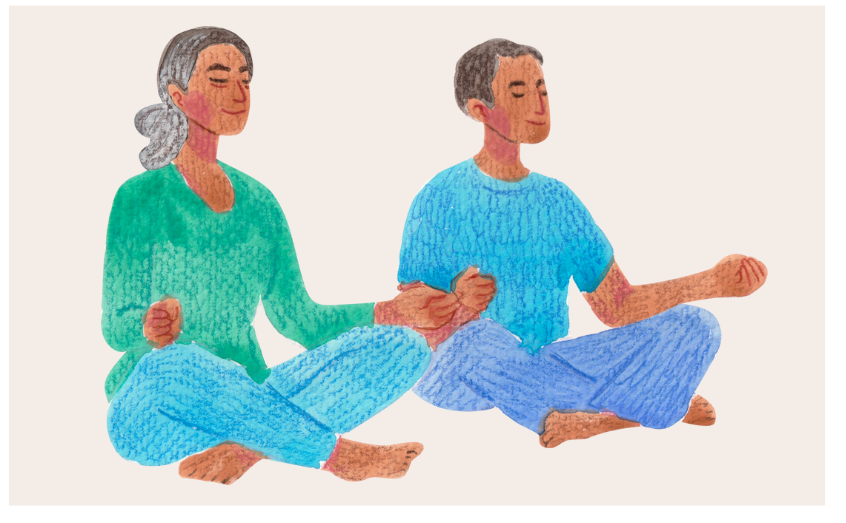» Physical and mental well-being
How to Meditate for Beginners: A Detailed Step-by-Step Guide
Introduction
Meditation, the practice of paying attention to the breath and noticing when the mind wanders, offers a variety of benefits for beginners [1]. By anchoring oneself in the present moment without judgment, meditation can provide much-needed space, help make better choices, understand pain, lower stress, improve focus, and reduce brain chatter [1] [2] [3].
To begin meditating, find a calm place, focus on your breath, and gently bring your attention back when your mind wanders – being kind and avoiding judgment [1]. This guide will cover finding a comfortable position, connecting with your breath, observing thoughts, and developing a routine to explore the benefits of meditation and mindfulness for beginners [1] [2] [3].
Find a Comfortable Position

For beginners looking to establish a meditation practice, finding a comfortable position is crucial. Here are some recommended postures:
- Seated on a Chair: Sit upright with feet flat on the floor, legs uncrossed, and arms resting on the legs or in the lap [4]. Ensure the back is straight but relaxed, with the head and neck aligned with the spine [4]. For additional support, sit on the edge of a sofa or use a chair with a backrest [4].
- Cross-Legged on the Floor: Sit on a cushion or folded blanket to elevate the hips above the knees [4] [5]. Use a zafu (meditation cushion) and zabuton (larger cushion) to support the knees and ankles comfortably [5]. Alternatively, sit on a bench with calves or ankles tucked under [5]. The goal is to maintain an upright yet natural spine [5] [6].
- Lying Down: For those with chronic knee or back pain, lying down can be a suitable option. Lie on the back with legs hip-width apart, arms by the sides, and palms facing up [4]. Place a pillow under the head or bend the knees with feet flat for lower back support [4] [5].
Regardless of the position chosen, it’s essential to find a quiet, calm space [7] and get comfortable [8]. Maintain an erect yet relaxed posture [9], allowing for focused attention on the breath and present moment.

Connect with Your Breath
Connecting with the breath is a fundamental aspect of meditation for beginners. Focus on your breath and gently bring your attention back when it wanders [7]. Allow your body to breathe naturally during meditation, without trying to control your breathing [10].
As an optional exercise, you can take several deep breaths to start – inhale through the nose and exhale through the mouth, which can help clear the mind [10]. Gradually transition to natural breathing, breathing through the nose with the mouth closed or slightly open [10].
During meditation, let your body, breath, and mind be as they are, while maintaining awareness [10]. Mindful breathing involves closely observing the process of inhalation and exhalation, noticing the sensations in the body as you breathe [10]. When the mind wanders, gently bring your attention back to the breath [10].

Here are some tips for connecting with your breath:
- Observe the Breath Cycle: Try to follow the breath through full cycles, from the beginning of an inhalation to the end of an exhalation [9]. Thoughts may arise, but simply allow them to come and go, gently returning your attention to the breath [9].
- Use Breath as an Anchor: Breath meditation is a simple and effective way to reduce stress and cultivate mindfulness [9]. Bring your attention to the natural sensations of the breath in your body, without trying to control the breath [9].
- Labeling the Breath (Optional): Mentally labeling the breath as ‘in/out’ can be a helpful tool [11]. If the breath is difficult to focus on, you can try using other anchors like sounds or bodily sensations [11].
- Build Mindfulness Muscle: Maintaining focus on the breath is challenging, especially for those used to being distracted. But with regular, kind practice, your ‘mindfulness muscle’ will build over time [11].
Observe Your Thoughts
During meditation, it’s natural for thoughts to arise and the mind to wander. Rather than suppressing or judging these thoughts, the practice involves observing them with a sense of detachment and gently redirecting attention back to the breath [7]. Here are some tips for observing thoughts during meditation:
- Acknowledge Thoughts Without Judgment: When thoughts arise, simply notice them without getting caught up in their content or meaning [7]. Avoid labeling them as good or bad, and resist the urge to analyze or dwell on them [7].
- Use a Mental Note: If a thought persists and distracts you from your breath, you can mentally note it with a label like “thinking” or “wandering” [7]. This acknowledgment can help you let go of the thought and return to your anchor (the breath) [7].
- Imagine Thoughts as Clouds: Visualize your thoughts as clouds passing through the sky of your mind [7]. Observe them without attachment, allowing them to come and go without getting caught up in their narrative [7].
- Cultivate Patience and Compassion: It’s natural for the mind to wander, especially for beginners [7]. Approach this process with patience and self-compassion, gently redirecting your attention without judgment or frustration [7].
Observing thoughts without judgment or attachment is a crucial aspect of meditation [7]. With regular practice, you’ll develop the ability to observe your thoughts with greater clarity and detachment, reducing the impact of distracting thoughts and cultivating a greater sense of inner peace and focus [7].
Develop a Routine
Developing a consistent meditation routine is key for beginners to experience the full benefits of the practice. Here are some tips to help establish a sustainable habit:

- Start Small: Begin with just 5 minutes of guided meditation, 3 times a week, and gradually increase the duration as you build the habit [8]. Committing to a short, consistent practice is important for building the foundation [10].
- Find the Right Time: Choose a time that works best with your schedule and responsibilities [8]. Many find it beneficial to meditate first thing in the morning – check in with yourself, set intentions for the day, and avoid digital devices or complex interactions until the practice is complete [7].
- Use Tools and Resources: Apps like Calm, Headspace, and Ten Percent Happier offer guided meditations and tools to support beginners [8]. Headspace even has guided walking and running meditations available [4]. Try different styles like a 5-minute gratitude practice, 10-minute body scan, or 30-minute meditation for resting awareness [7].
- Be Patient and Kind: When your mind wanders, gently bring it back to the breath without judgment [7]. Meditation takes regular practice, so be patient and kind with yourself throughout the process [7].
- Incorporate Mindfulness: In addition to a dedicated sitting practice, incorporate mindfulness into daily tasks like brushing teeth, showering, or drinking coffee [7]. Mindful movement practices like dynamic stretches can also support your routine [7].
- Create a Conducive Environment: Avoid jarring alarm sounds, keep lights low, and limit digital/electronic exposure before and during your practice [7]. End each session with a few deep breaths and a brief visualization or intention for the day [7].
By consistently dedicating time to meditation, even just 15 minutes per day, you can significantly improve your quality of life and cultivate a calm, contented mind that appreciates more and makes better decisions [10].

FAQs
How Can Beginners Start Meditating in a Step-by-Step Manner?
To begin meditation as a beginner, follow these seven key steps:
- Allocate Time: Setting aside time for regular meditation sessions is crucial.
- Find a Comfortable Space: Choose a spot where you can be undisturbed and comfortable.
- Incorporate Mindfulness: Engage in meditation with an awareness of the present.
- Initiate the Meditation: Begin your practice.
- Focus Your Mind: Work on concentrating your mind, despite the challenges.
- Practice Regularly: With consistent practice, you’ll become more adept at meditating.
- Conclude Your Session: End your meditation mindfully.
What Constitutes the Seven Stages of Meditation?
The seven stages of meditation are outlined as follows:
- Body: Focusing on the physical sensations.
- Feelings: Observing emotions without judgment.
- Awareness: Cultivating a state of open, nonjudgmental awareness.
- Loving-kindness: Generating feelings of goodwill towards oneself and others.
- Release: Letting go of attachments and aversions.
- Self-fulfillment: Realizing a sense of inner peace and contentment.
- Nonduality: Experiencing a state of oneness with all that is.
These stages provide a framework for progressing in meditation and can be compared to practices in various religious traditions.
What are the Five Stages of Meditation?
The process of meditation can be broken down into five stages:
- Intention: Deciding to meditate is the foundational step.
- Concentration: Focusing your attention is the second crucial step.
- Insight: Maintaining focus allows for deeper understanding and insights.
- Sensitivity: Becoming more attuned to sensations and emotions.
- Release: Letting go of all efforts to achieve a state of natural awareness.
Can You Outline the 10 Steps to Begin Meditating?
To start meditating, follow these ten steps:
- Preparation: Address any practical concerns before beginning.
- Find a Quiet Space: Choose a place where you can be undisturbed.
- Deep Breathing: Use deep breaths to relax your body and mind.
- Check-In: Pay attention to your current state of being.
- Body Scan: Gently notice sensations throughout your body.
- Understand Your ‘Why’: Reflect on the reasons behind your meditation practice.
- Observe Your Breath: Focus on the natural rhythm of your breathing.
- Free Your Mind: Allow thoughts to pass without attachment.
By following these steps, you can establish a meditation practice that suits your lifestyle and preferences.
References
[1] – https://www.mindful.org/how-to-meditate/
[2] – https://www.mayoclinic.org/tests-procedures/meditation/in-depth/meditation/art-20045858
[3] – https://www.healthline.com/nutrition/12-benefits-of-meditation
[4] – https://www.headspace.com/meditation/positions
[5] – https://www.youtube.com/watch?v=JwhP-veUubk
[6] – https://www.mindful.org/how-to-sit-in-meditation-for-beginners/
[7] – https://www.mindful.org/how-to-start-your-day-with-meditation/
[8] – https://www.healthline.com/health/daily-meditation
[9] – https://www.health.harvard.edu/mind-and-mood/breath-meditation-a-great-way-to-relieve-stress
[10] – https://mindworks.org/blog/how-to-breathe-properly-when-meditating/
[11] – https://www.mindful.org/how-to-practice-mindful-breathing/
[12] – https://mindworks.org/blog/breathing-techniques-meditation/

